1. Percentage Basics: Definition & Notation
At its heart, a percentage is a way of expressing a fraction out of 100. The word itself comes from Latin "per centum" meaning "by the hundred." When you say 25%, you're saying "25 out of 100" — equivalent to the fraction 25/100 or the decimal 0.25. Understanding this simple equivalence is the foundation for everything that follows.
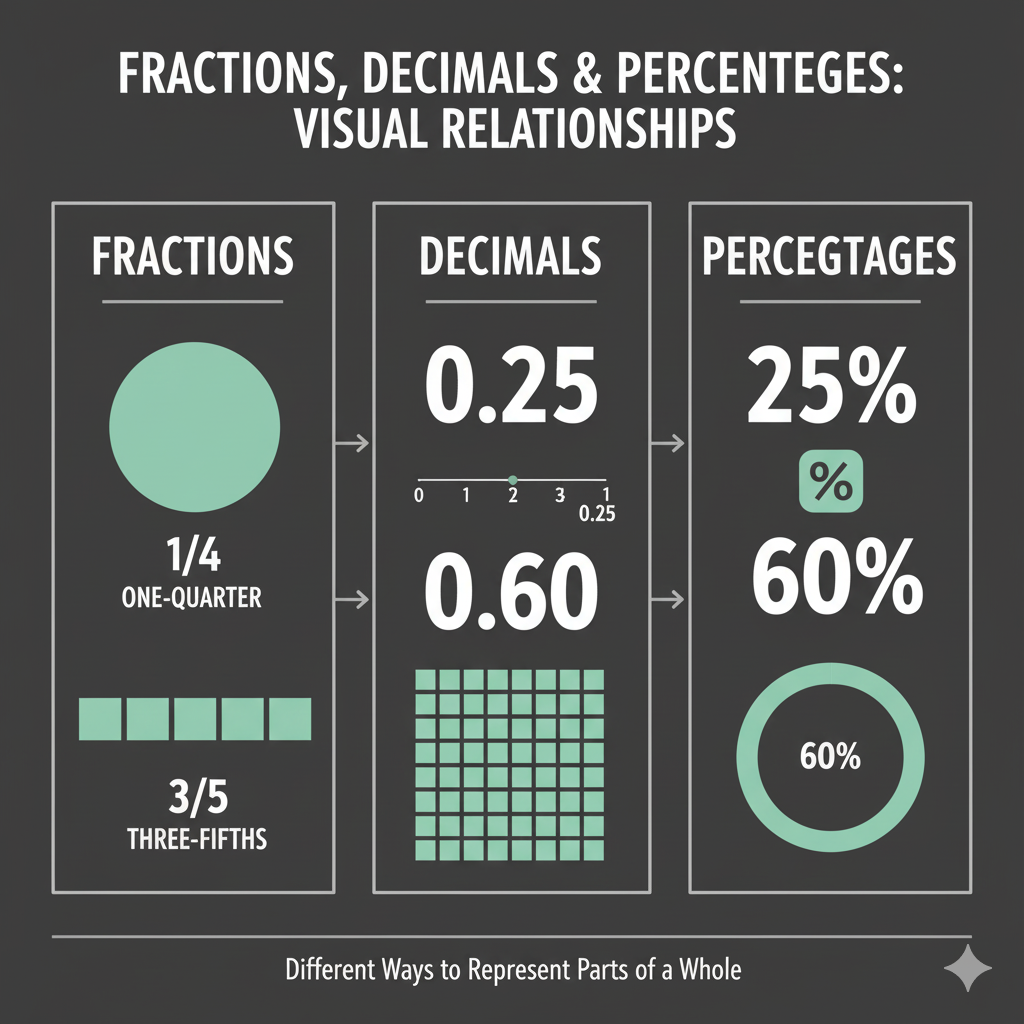
Why Percentages Are Useful
Percentages let us compare quantities of different sizes quickly and intuitively. They are used everywhere: finance (interest rates), shopping (discounts), statistics (market share), health (body fat %), education (test scores), and more. Because the scale is fixed to 100, percentages are an excellent way to standardize comparisons.
of adults use percentages in their daily lives, according to a recent survey on mathematical literacy.
Notation & Conversion
Understanding how to convert between different representations is crucial for working with percentages effectively:
- Percent sign:
%— e.g.,45%. - To convert a percentage to a decimal: divide by 100. Example: 12.5% →
0.125. - To convert a decimal to a percentage: multiply by 100. Example: 0.07 →
7%. - To convert a fraction to a percentage: divide numerator by denominator, then multiply by 100.
2. The History and Evolution of Percentages
The concept of percentages has a fascinating history that dates back to ancient civilizations. The Romans used a similar system for calculating taxes, but the modern percentage symbol (%) only emerged in the 15th century with the development of commerce and trade.
Italian mathematicians were among the first to systematically use percentages in the Renaissance period. The term "per cento" (for each hundred) was abbreviated to "p cento" and eventually evolved into the symbol we use today. By the 17th century, percentage calculations were standard in business and commerce across Europe.
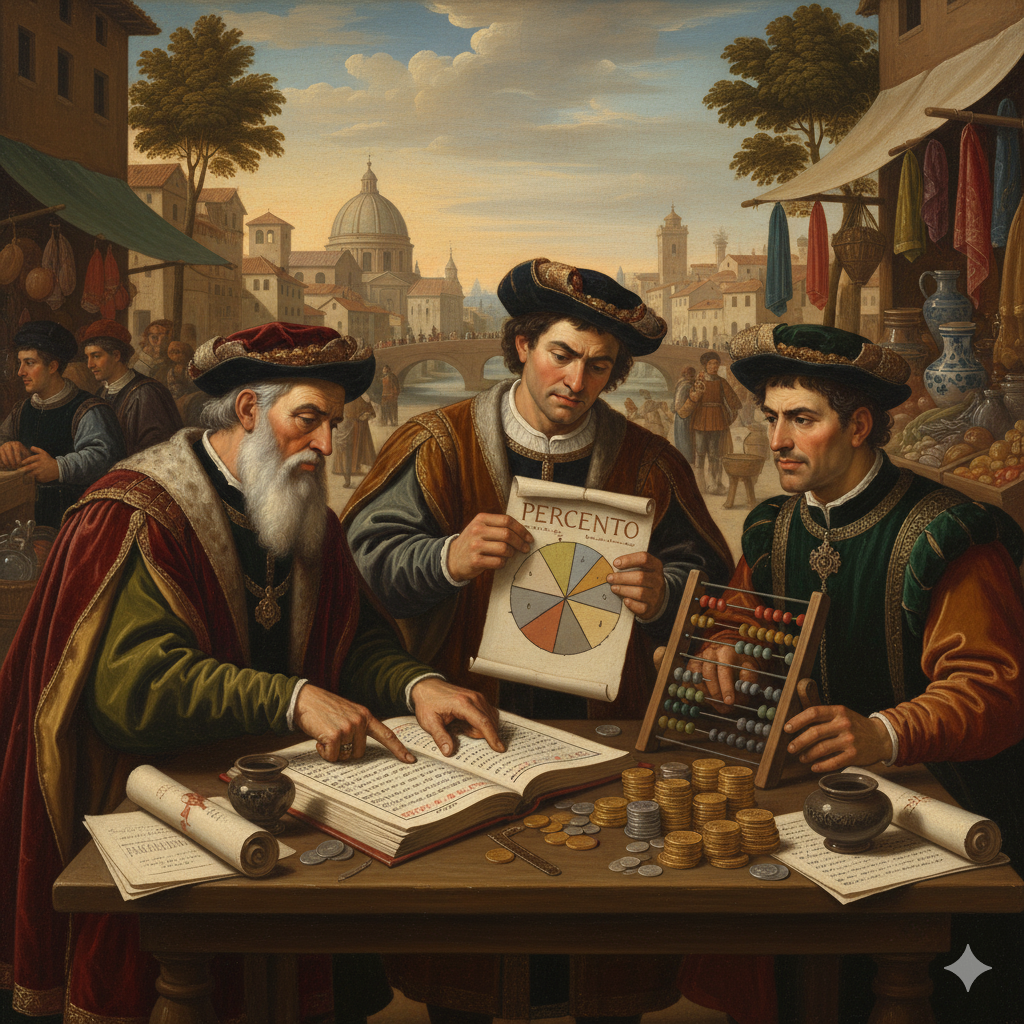
In the 20th century, percentages became even more important with the rise of statistics, economics, and social sciences. Today, they're an essential part of financial literacy and data interpretation across all fields.
3. Core Calculation Methods
There are a handful of percentage calculations you'll use again and again. We'll list them, show formulas, and then go into detailed examples.
3.1 Find X% of a Number (Percentage of a Number)
Formula: percentage_of = number × (percentage / 100)
Calculation:
250 × 0.18 = 45. So 18% of 250 is 45.
3.2 Find What Percentage One Number Is of Another
Formula: percentage = (part / whole) × 100
Calculation:
(30 / 200) × 100 = 15%.
3.3 Percentage Increase / Decrease (Percentage Change)
Formula: percentage_change = ((new - old) / old) × 100. Use positive result for increase, negative for decrease.
((150-120)/120)×100 = 25% increase.
3.4 Reverse Percentage / Find Original Number Before Percentage
Sometimes you have a discounted price and you want to know the original. If after applying p% the result is final, the original is original = final / (1 - p/100) for discounts. For markups use original = final / (1 + p/100) depending on how the percentage was applied.
Calculation:
85 / (1 - 0.15) = 85 / 0.85 = 100. So the original price was $100.
3.5 Percentage Points vs Percent Change — The Important Distinction
Say a rate increases from 5% to 7% — that's a 2 percentage point rise, which is actually a 40% relative increase because ((7-5)/5)×100 = 40%. Be careful with wording: "percentage points" is an absolute difference between percentages; "percent" usually refers to relative change.
4. Worked Examples (Practical & Exam-Style)
The best way to build intuition is practice. Below we walk through dozens of examples, organized by topic: shopping, finance, data interpretation, exam prep, and teaching exercises you can use in class.
Shopping & Discounts
Imagine an item has a "30% off" discount and the sale price is $84. What was the original price?
We reverse the percentage: original = 84 / (1 - 0.30) = 84 / 0.70 = 120. So it cost $120 originally.
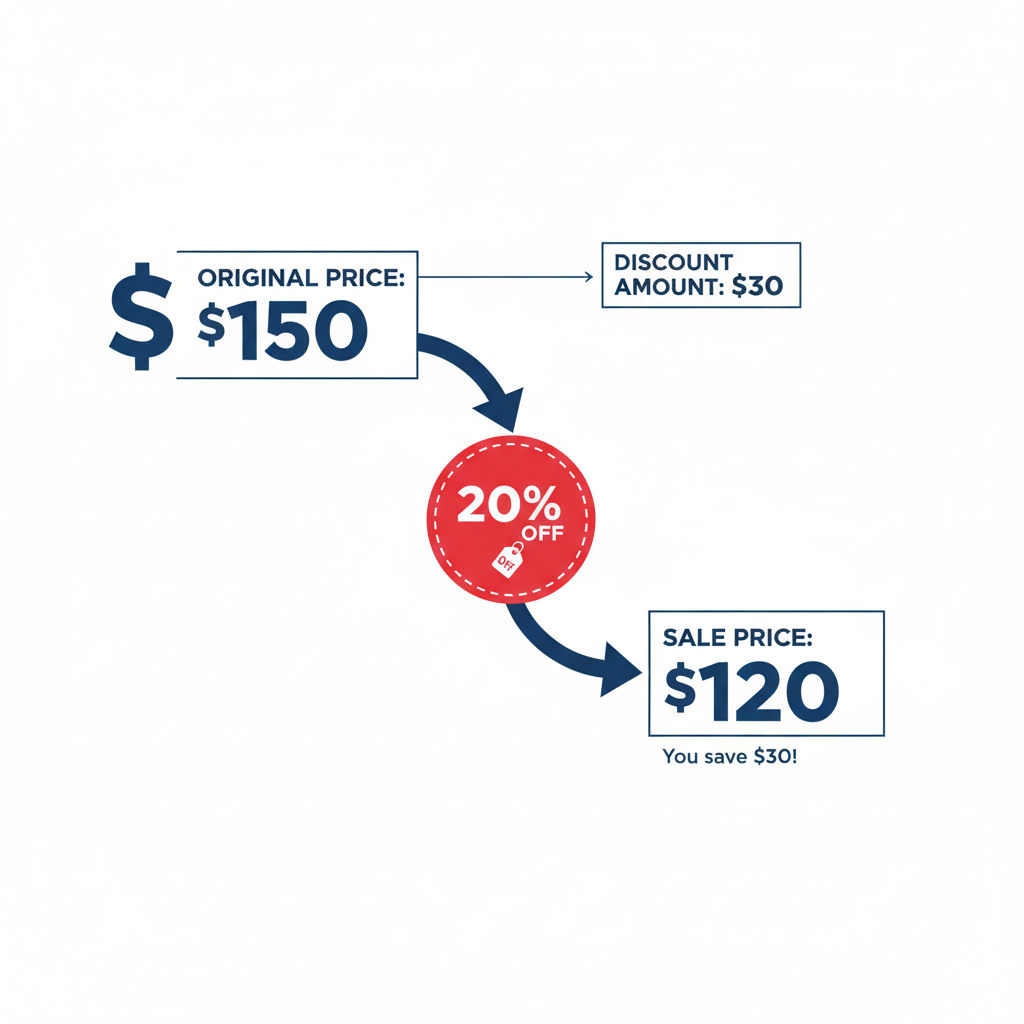
Tax & Tip Calculations
Tip and tax are easy with percentages. If your bill is $42 and local sales tax is 8.25% and you'd like to tip 18% on the pre-tax amount, compute:
- Tax:
42 × 0.0825 ≈ 3.465 - Tip:
42 × 0.18 = 7.56 - Total pay:
42 + 3.465 + 7.56 ≈ 53.025
Finance: Interest Rates & Returns
Percentages are everywhere in finance. Annual interest rates, yields, returns and APRs use percent notation. If you get a 6% annual return on $5,000 invested for one year (simple), the interest earned is 5000 × 0.06 = 300.
Percentage Change Examples
A population grows from 1,200 to 1,500. Percentage increase: ((1500-1200)/1200)×100 = 25%.
Compound Percent Problems (Multi-Step)
When percentages apply sequentially — e.g., a price increases by 10% then decreases by 15% — multiply the factors: new = original × 1.10 × 0.85. Note the result is not symmetric: +10% then -10% ≠ original.
Calculation:
200 × 1.10 × 0.90 = 200 × 0.99 = 198. The final price is $198, not $200.
5. Common Mistakes & How to Avoid Them
- Mixing percent points and percent change — say "percentage points" for absolute changes between percentages.
- Forgetting to convert to decimal — 5% is
0.05, not5. - Applying percent on wrong base — always check whether percentage applies to original, new, subtotal, or total.
- Ignoring compounding — repeated percentage changes multiply, they don't add.
- Misinterpreting percentage decrease — a 50% decrease followed by a 50% increase does not return to the original value.
6. Mental Math Shortcuts & Tricks
Use these tricks to work percentages in your head faster.
- 10% trick: Move decimal one place left. 10% of 350 = 35.
- 5% trick: Half of 10%: 5% of 350 = 17.5.
- 1% trick: Move decimal two places left: 1% of 6,250 = 62.5.
- 25% trick: Quarter (divide by 4). 25% of 200 = 50.
- Multiples: For 18% use 20% - 2% (i.e., take 20% then subtract twice 1%), etc.
- Combining percentages: To increase by 15% then 20% multiply by 1.15 × 1.20 = 1.38, i.e., +38% overall.
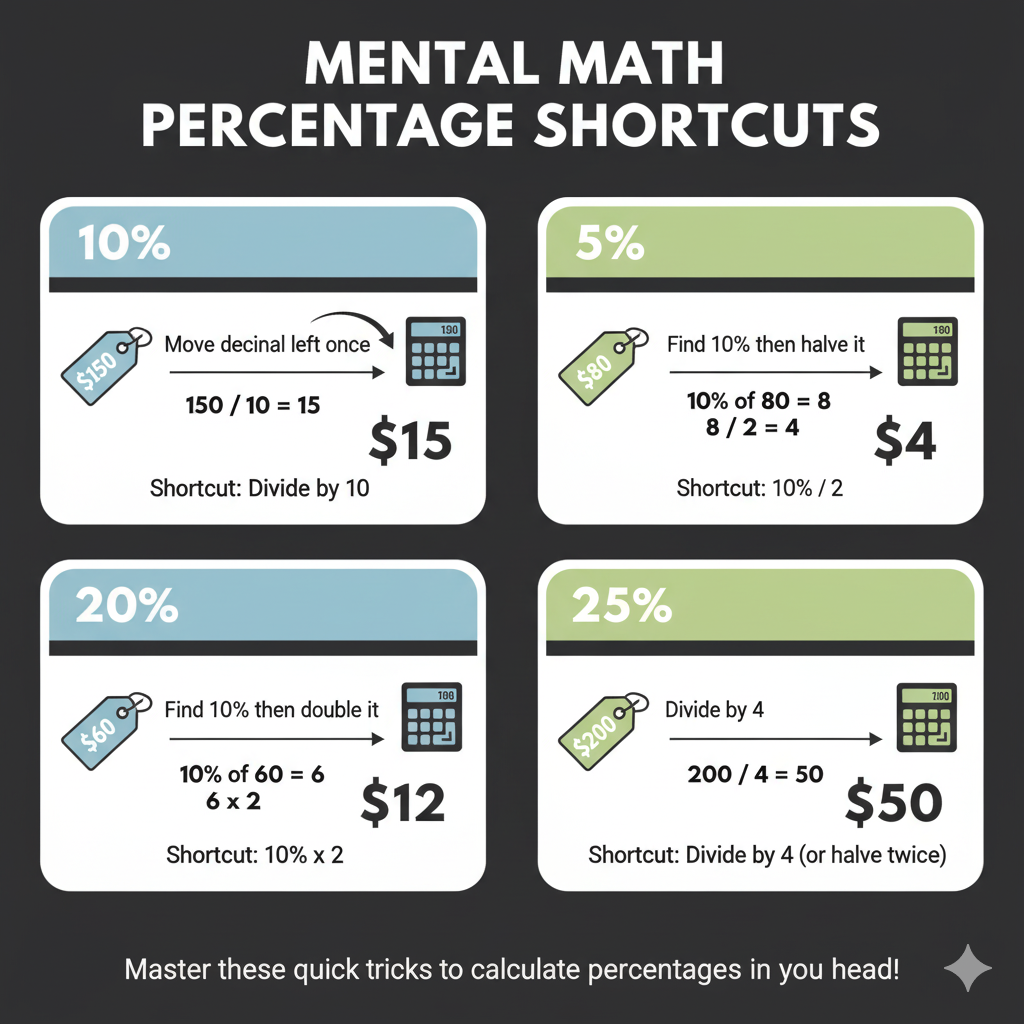
Quick Mental Method for Percent Change
When numbers are close, approximate change: (difference / average) × 100 gives a rough relative change (useful for a quick estimate).
7. Percentages in Finance (Deep Dive)
Percentages appear in many financial contexts — APR, APY, ROI, interest rates, fees, margins, discounts, and taxation. We'll cover common scenarios and how to calculate the relevant percentages safely.
APR vs APY
APR (Annual Percentage Rate) typically ignores compound interest while APY (Annual Percentage Yield) accounts for compounding. If interest compounds m times per year at nominal rate r, then APY = (1 + r/m)^m - 1. Convert to percentage by multiplying by 100.
(1 + 0.12/12)^12 - 1 ≈ 0.1268 or 12.68%.
Return on Investment (ROI)
ROI = ((gain - cost) / cost) × 100. Use this to compare investment performance on a relative basis.
Markup vs Margin
Tricky but important distinction in business: markup is based on cost, margin is based on sale price. If cost = $60 and sale price = $100, markup = ((100-60)/60)×100 = 66.67%. Margin = ((100-60)/100)×100 = 40%. When communicating with others, be explicit which you mean.
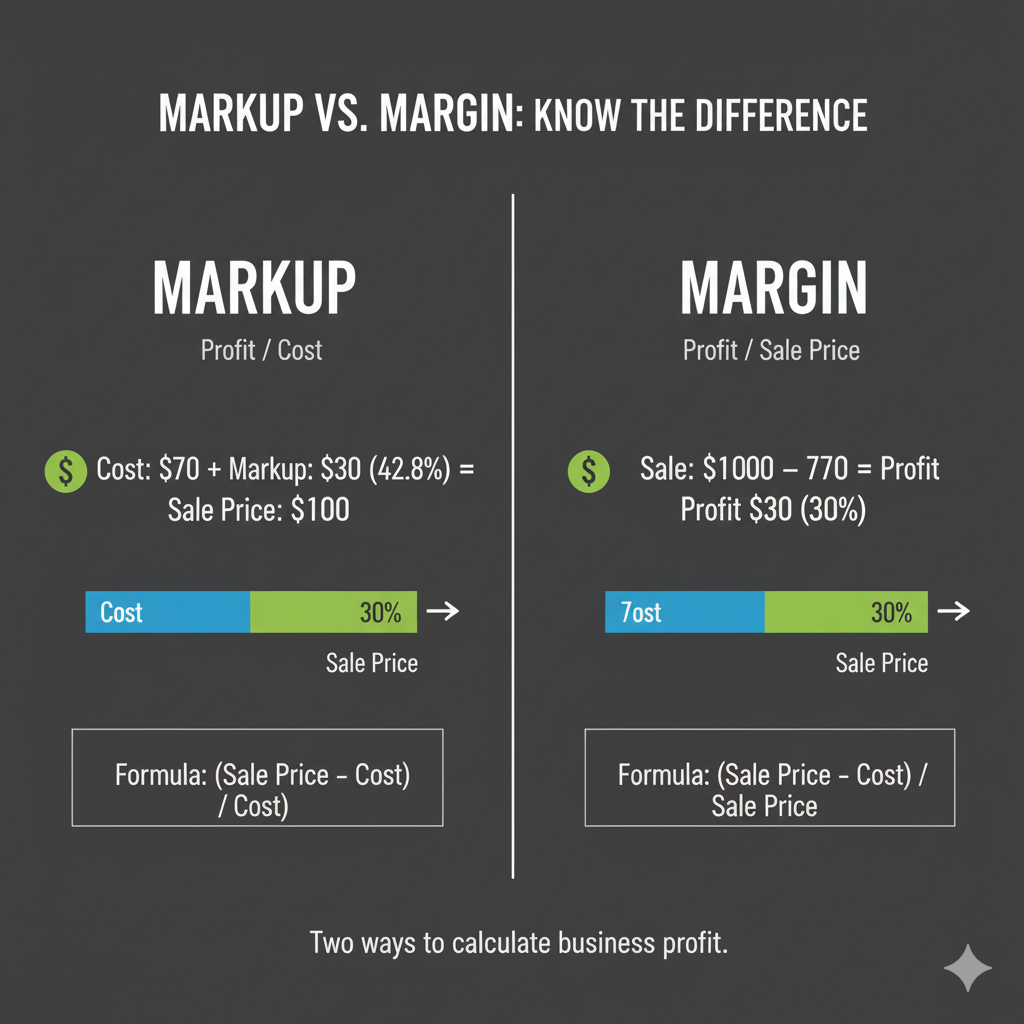
8. Exam Tips & Teaching Guides
Students often face percentage questions on standardized tests. Here are practical strategies and practice exercises to improve speed and accuracy.
- Memorize the basics: 1%, 5%, 10%, 25%, 50% conversions and common decimal equivalents.
- Show steps: On exams, show concise steps—teachers award partial credit for method.
- Check units: Is the question asking for absolute difference, percentage points, or percent change?
- Practice mental shortcuts: Use 10%/5%/1% shortcuts when time pressure exists.
- Estimate first: Get a ballpark figure to check if your final answer makes sense.
Classroom Activity Suggestions
Use real-world data: shopping receipts, sports stats, or school grades. Ask students to compute percent change, percentage of total, and create visual charts to build intuition.
9. Visualizing Percentages
Visual representations can make percentage concepts much easier to understand. Here are some effective ways to visualize percentages:
Pie Charts
Pie charts are perfect for showing parts of a whole. Each slice represents a percentage of the total, making it easy to compare proportions visually.
Bar Graphs
Bar graphs can show percentage changes over time or compare percentages across different categories.
100s Grids
For foundational learning, 10x10 grids with shaded squares provide a concrete representation of percentages that helps build intuition.
10. Real-World Applications of Percentages
Percentages are used in countless real-world scenarios. Understanding these applications makes learning percentages more relevant and engaging:
Personal Finance
From calculating tips and discounts to understanding interest rates on loans and investments, percentages are essential for financial literacy.
Health and Nutrition
Nutrition labels use percentages to show how much a serving contributes to daily values. Body fat percentages and hydration levels are also common health metrics.
Sports Statistics
Player success rates (like shooting percentages in basketball), team winning percentages, and performance improvements are all expressed with percentages.
Science and Data Analysis
Percentages are used to express concentrations, error margins, confidence intervals, and changes in scientific measurements.
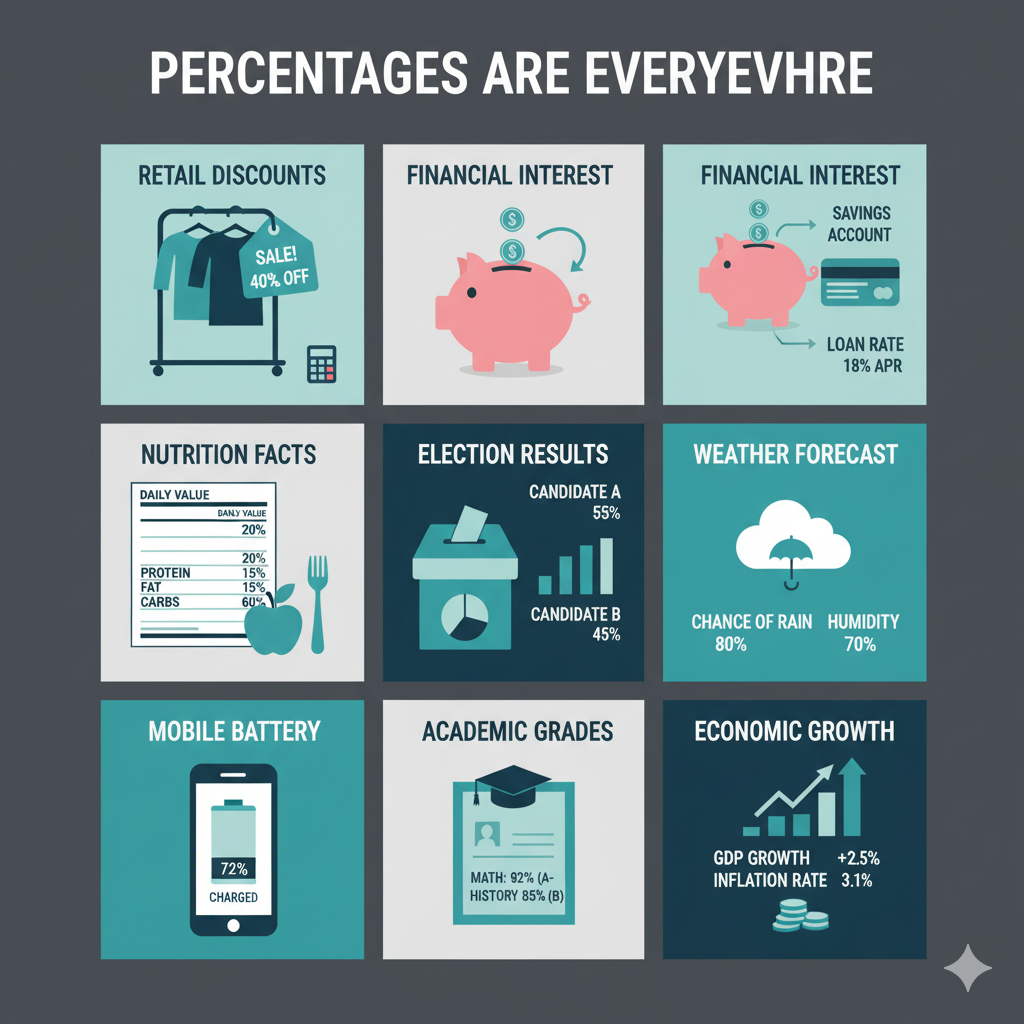
11. Frequently Asked Questions
Q: How do I calculate 15% tip on a restaurant bill?
A: Multiply the bill by 0.15. For $62.50 bill, tip = 62.5 × 0.15 = 9.375 (round to currency precision).
Q: If a price drops by 25% and then increases by 25%, is it back to original?
A: No. A 25% drop multiplies the price by 0.75. A 25% increase multiplies by 1.25. Combined multiplier = 0.75 × 1.25 = 0.9375, which is a net decrease of 6.25%.
Q: What is the difference between percent and percentage points?
A: A change from 4% to 6% is a 2 percentage point increase but a 50% relative increase.
Q: Can the percentage calculator help with taxes and tips?
A: Yes — use the percentage calculator to compute taxes, tips, discounts, markups, and reverse percentages quickly.
Q: How do I calculate a percentage greater than 100%?
A: Percentages greater than 100% represent values larger than the whole. For example, 150% of 80 is 80 × 1.50 = 120.
Q: Why do we sometimes see percentages over 100% in news reports?
A: This often represents growth beyond the original amount. For example, if a company's profits were $100,000 and grew to $250,000, that's a 150% increase.
12. Resources & Related Calculators
Use these related pages on Proculator to extend your workflow:
- Percentage Tricks — quick mental methods
- Percentage Calculator (interactive)
- Compound Interest Calculator
- Calculator Productivity Tips
- Trip Calculator
Try Our Percentage Calculator
Put your knowledge into practice with our interactive percentage calculator that handles all types of percentage problems.
Use Percentage Calculator13. Advanced Percentage Concepts
For those looking to expand their percentage knowledge beyond the basics, here are some advanced concepts:
Weighted Percentages
When combining percentages across different bases (e.g., different class sizes for grades), compute a weighted average: weighted = (sum of (weight × percent)) / sum of weights. Example: Class A 30 students avg 80%, Class B 20 students avg 90%: combined = ((30×80)+(20×90))/50 = (2400+1800)/50 = 84%.
Percentiles
Percentiles indicate the value below which a given percentage of observations fall. For example, if you score in the 90th percentile on a test, you scored better than 90% of test-takers.
Compound Annual Growth Rate (CAGR)
CAGR smooths annual growth rates over multiple periods: CAGR = (Ending Value / Beginning Value)^(1/Number of Years) - 1. This is expressed as a percentage.
(1500/1000)^(1/3) - 1 ≈ 0.1447 or 14.47%.
Percentage Difference
Different from percentage change, percentage difference compares two numbers without regard to which is initial or final: Percentage Difference = (|Value1 - Value2| / ((Value1 + Value2)/2)) × 100.